As technology continues to advance, the world of cellular network technology is constantly evolving. Every few years, a new mobile network generation emerges, each with a specific set of standards that must be met before it can be classified as a new generation. The responsibility of setting the standards for a new mobile network generation falls on the International Telecommunication Union (ITU).
Each mobile network generations is defined by its standard bandwidth, frequency of operation, network standard, and multiple access system, and ITU ensure that any new network technology meets these standards before accepting it as a mobile network generation.
Also, before approving a network technology as a network Generation, ITU take contemporary advancements into consideration, which not only expand the potential range and power of existing networks but also define the scope of what the next generation of systems will be capable of achieving.
This post will provide an overview of each mobile network generations, including its network standards, multiple access systems, performance, and more.
What Is a Network Generation?
Network generation is a cellular technology characterized by a set of standards that define the technology’s capabilities and features, such as its bandwidth, frequency of operation, network standard, and multiple access system.
A new network generation emerges every few years as technological advancements are made, with each generation providing faster speeds, more reliable connections, and expanded capabilities compared to the previous one.
Below are the mobile network generations and their features.
Pre-Cellular Mobile Radio Telephone (0G)
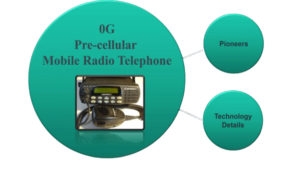
Pre-cellular Mobile Radio Telephone (0G) refers to the earliest form of wireless telecommunication technology. This technology emerged in the mid-20th century and used analog radio signals to transmit voice signals over a limited distance.
0G used the technology known as push-to-talk mobile (PTT). Push-to-talk is a technology where you will need to press and hold the device button while listening to the other side first (similar to using a walkie-talkie).
Other technologies used by 0G are Mobile Telephone Service (MTS), Improved Mobile Telephone Service (IMTS), and Advanced Telephone System (AMTS), which give full duplex coverage and higher voice quality.
The first commercial mobile phone service was launched in 1946 in the United States and used a radio network to provide telephone service to automobile drivers. However, this service was limited to a single channel, which means that only one conversation can be carried out at a time within a particular coverage area.
The 0G technology used large and heavy handsets that could only be used in a specific location with the aid of external antennas. The system was also not reliable and suffered from interference from other signals and a limited range.
First Mobile Generation Network (1G)
The first generation of cellular technology, 1G, emerged in the early 1980s and was based on analog technology. It was first launched in Japan in 1979, and the United States followed suit in 1983.
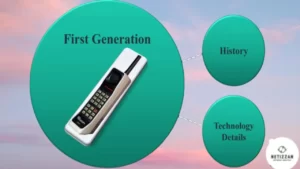
1G networks
1G networks did not have a standard network protocol or data transfer rate, which meant that they were primarily designed for voice communication. The maximum speed and frequency achieved with this generation are 2.4 kbps and 150 MHz, respectively.
In order to provide coverage over a long distance in 1 G networks, cell towers were built in various locations across the country. The use of cell towers allowed for signals to be transmitted and received over greater distances.
The 1G network was prone to issues such as dropped calls and interference from other radio signals. Additionally, the lack of encryption in the network made it vulnerable to security breaches, such as hacking.
1.5G Network
1.5G mobile networks were an intermediate step (generation) between 1G and 2G networks. This network technology was introduced in the late 1980s and early 1990s to provide better voice and data services, which is the main drawback of the First Generation network.
This network technology made use of both analog and digital technology to provide voice quality and faster data transfer that the 1G network simply could not provide.
1.5G networks also introduced the use of time-division multiple access (TDMA) and code-division multiple access (CDMA) technologies, which allowed for more efficient use of the available radio spectrum and improved network capacity.
One of the key features of 1.5G networks was the use of packet-switched data transmission, which allowed for more efficient data transfer compared to the circuit-switched transmission used in 1G networks. Packet-switched transmission enabled faster data transfer rates and more efficient use of network resources, paving the way for more advanced data services in future generations.
Second Mobile Generation Network (2G)
2G networks are the network technology that enhanced the shift from analog to digital communications and introduced a range of new features and capabilities to the telecommunications industry. This network generation was introduced in the early 1990s in Finland by Radiolinja, and it marked a major step in the evolution of mobile networks.
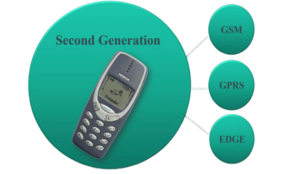
The major advantage of 2G networks is their ability to carry voice and data traffic digitally. This meant that voice calls were clearer and more reliable, and data transfer rates were significantly faster than on 1G networks (up to 14.4 kbps).
2G networks introduced a range of new services that were not possible with 1G networks. Some of those services include SMS (short messaging service) and MMS (multimedia messaging service).
The first 2G network standard was called the Global System for Mobile Communications (GSM), which became the most widely used standard in the world. GSM used a combination of TDMA and Frequency Division Multiple Access (FDMA) technologies to improve network capacity and efficiency.
Speaking of the transfer speed of the 2G network, the GSM standard allowed a data rates of up to 9.6 kbps for circuit-switched data and up to 14.4 kbps for packet-switched data using GPRS.
2.5G Network: GPRS
General Packet Radio Service (GPRS) is another 2G standard that was released in 1993 by ETSI. The big difference between GPRS and GSM was the use of packet-switching technology, where the information to be sent to the destination was divided into packets and sent in parallel.
This network standard achieved a maximum downlink speed of 53.6 Kbps and an uplink speed of 26.8Kbps.This high-speed enhancement of GPRS introduced MMS (Multimedia Message Service), which allowed the user to send and receive media like pictures.
2.75G Network.
The last 2G standard is EGDE (Enhanced Data Rates for GSM Evolution), and it is referred to as 2.75G. It was introduced by AT&T in 2003, and the maximum speed was 236.8 kbps for downlink and 59.2 kbps for uplink.
Third Mobile Generation Network (3G)
The 3G network, which was released commercially in 2001 by SK Telecom South Korea, brought significant improvements over its predecessors in terms of speed. It uses packet-switched technology, allowing for faster data transfer rates and more efficient use of network resources.
With the improved data transfer rates, 3G users can browse the web, send emails, and use more advanced apps and services on their mobile devices.
The first network standard for 3G was WCDMA (Wideband Code Division Multiple Access), also known as UMTS (Universal Mobile Telecommunications System). WCDMA was developed by the 3rd Generation Partnership Project (3GPP), a collaboration between multiple telecommunications standards organizations.
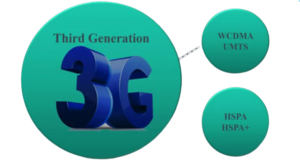
The 3G network used Code Division Multiple Access (CDMA) for multiplexing and followed the packet switching paradigm using three main frequency bands of 850, 1900, and 2100 MHz.
The maximum speed was dependent on device mobility. For movie devices like mobile phones, it has a max speed of 384 kbps, while for non-movie devices, the max speed is 2 Mbps.
3.5 G Network (HSPA)
3.5G network, also known as High-Speed Packet Access (HSPA), is an enhancement of the 3G mobile network technology. It is a combination of two technologies: High-Speed Downlink Packet Access (HSDPA) and High-Speed Uplink Packet Access (HSUPA).
HSPA was first introduced in 2006 and it provided faster data transfer rates, lower latency, and improved voice call quality compared to 3G. With HSDPA, data transfer rates of up to 14.4 Mbps were achievable while HSUPA enabled data uploads at up to 5.8 Mbps.
3.75 G Network (HSPA+)
HSPA is the evolved version of HSPA that uses MIMO (multiple input-multiple output) network Standard. This standard drastically increased the speed of network to a theoretical value of 22Mbps for Uplink and 168Mbps for downlink
Fourth Mobile Generation Network (4G)
The 4G network
One of the key features of 4G is its high-speed data transfer capability. It allows for download speeds of up to 1 Gbps, which is significantly faster than the previous 3G technology. This faster speed enables smoother streaming of high-quality videos, online gaming, and faster downloads of large files.
Another important feature of 4G is its low latency, which means there is less delay in data transfer between devices. This is important for applications that require real-time communication, such as video conferencing and online gaming.
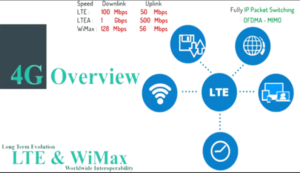
4G uses a network standard called Long-Term Evolution (LTE), which is a standard for wireless broadband communication. It employs a multiple access system called orthogonal frequency-division multiple access (OFDMA), which enables more efficient use of bandwidth by allowing multiple devices to transmit data simultaneously.
In addition to faster and more reliable internet connectivity, 4G also offers improved security features, such as encryption and authentication protocols. This ensures that users’ data is protected from unauthorized access and interception.
Fifth Mobile Generation Network (5G)
Fifth Generation Network (5G) is the latest and most advanced mobile network technology developed to meet the increasing demand for faster and more reliable data transfer speeds.
The key benefits of 5G include higher data transfer speeds, lower latency, increased network capacity, and improved connectivity. With 5G, users can download large files, stream high-quality videos, and participate in high-quality video conferencing seamlessly. Theoretically, it is estimated that the download speed of 5G is 20 times faster than 4G.
In addition to high-speed performance, 5G also enables the development of new technologies such as self-driving cars, augmented reality, and the Internet of Things (IoT). These technologies require a high-speed, low-latency network to function properly, and 5G provides just that.
The 5G network was built with 5G New Radio (NR), which is a global standard developed by the 3rd Generation Partnership Project (3GPP) to provide a unified framework for the next generation of wireless communications.
5G NR uses a combination of frequency bands, including both sub-6 GHz and millimeter wave (mmWave) frequencies, to provide faster data speeds, lower latency, and more reliable connectivity. It also incorporates advanced technologies such as massive MIMO, beamforming, and dynamic spectrum sharing to improve network performance and efficiency.
The 5G network uses a variety of multiplexing technologies, including orthogonal frequency division multiplexing (OFDM), multiple input, multiple output (MIMO), and millimeter wave (mmWave) frequency bands.
Beyond 5g Networks (6G)
Although 5G networks were developed to address some of the drawbacks identified with earlier network generations, research has begun for a network that will overcome the limitations of 5G networks. These networks are expected to provide even faster data speeds, lower latency, and more reliable connectivity than 5G.
One of the key technologies being explored beyond 5G networks is terahertz (THz) communication, which uses the extremely high-frequency bands above 100 GHz. THz communication has the potential to provide data rates of up to several terabits per second, which is several times faster than the peak data rates of current 5G networks.
Another technology being researched for beyond 5G networks is free-space optical communication (FSO), which uses light waves to transmit data through the atmosphere. FSO has the potential to provide very high data rates, low latency, and immunity to interference from other wireless signals.
Other technologies being explored beyond 5G networks include non-orthogonal multiple access (NOMA), which allows multiple users to share the same radio resources at the same time, and artificial intelligence (AI) and machine learning (ML) techniques to optimize network performance and improve energy efficiency.
Mobile Network Generation Comparison
Base on speed, network standard and multiple access systems, the table shows a comparison of mobile network generation.
| Generation | Network Standard | Download Speeds | Upload Speed | Intermediate Generation | Multiple access system | Year of implementation |
|---|---|---|---|---|---|---|
| 0G | 1946 | |||||
| 1G | NMT, AMPS, TACS | 2.4 kbps | 2.4 kbps | 1.5G | FDMA | 1979 |
| 2G | GSM, GPRS, EDGE | 14.4 kbps | 9.6 kbps | 2.5G, 2,75G | TDMA, FDMA | 1991 |
| 3G | WCDMA, UMTS | 7.2Mbps | 2 Mbps | 3.5G, 3.75G, 3.95G | CDMA | 2001 |
| 4G | LTE, WiMAX, HSPA+ | 150Mbps | 50 Mbps | 4,5G, 4.9G | OFDMA | 2007 |
| 5G | NR | 20 Gbps | 10 Gbps | 5.25G | FDM, TDM, MIMO | 2018 |
Conclusion
This post so far has provided a comprehensive overview of each mobile network generation, from 0G to 5G, and their features such as network standard, multiple access system, and speed performance. With each network generation, there has been a significant improvement in technology, resulting in faster speeds, more reliable connections, and increased capacity.
There is already talk of going beyond 5G networks, which will likely bring even more advancements and innovations in wireless technology. As mobile networks continue to evolve, it will be interesting to see how they impact our daily lives and the world around us.

I am a passionate Networking Associate specializing in Telecommunications.
With a degree in Electronic engineering, I possess a strong understanding of electronic systems and the intricacies of telecommunications networks. I gained practical experience and valuable insights working for a prominent telecommunications company.
Additionally, I hold certifications in networking, which have solidified my expertise in network architecture, protocols, and optimization.
Through my writing skills, I aim to provide accurate and valuable knowledge in the networking field.
Connect with me on social media using the links below for more insights.
You can contact me using [email protected] or connect with me using any of the social media account linked below


